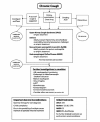Cough management: a practical approach
- PMID: 21985340
- PMCID: PMC3205006
- DOI: 10.1186/1745-9974-7-7
Cough management: a practical approach
Abstract
Cough is one of the most common symptoms for which patients seek medical attention from primary care physicians and pulmonologists. Cough is an important defensive reflex that enhances the clearance of secretions and particles from the airways and protects the lower airways from the aspiration of foreign materials. Therapeutic suppression of cough may be either disease-specific or symptom related. The potential benefits of an early treatment of cough could include the prevention of the vicious cycle of cough. There has been a long tradition in acute cough, which is frequently due to upper respiratory tract infections, to use symptom-related anti-tussives. Suppression of cough (during chronic cough) may be achieved by disease-specific therapies, but in many patients it is often necessary to use symptomatic anti-tussives, too. According to the current guidelines of the American College of Chest Physician on "Cough Suppressants and Pharmacologic Protussive Therapy" and additional clinical trials on the most frequent anti-tussive drugs, it should be possible to diagnose and treat cough successfully in a majority of cases. Among drugs used for the symptomatic treatment of cough, peripherally acting anti-tussives such as levodropropizine and moguisteine show the highest level of benefit and should be recommended especially in children. By improving our understanding of the specific effects of these anti-tussive agents, the therapeutic use of these drugs may be refined. The present review provides a summary of the most clinically relevant anti-tussive drugs in addition to their potential mechanism of action.
Figures



References
-
- Eccles R. Acute cough: epidemiology, mechanisms and treatment. Acute and chronic cough. Lung biology in health and disease. Redington A, Morice A (eds) 2005;205:215–236.
-
- Pratter MR. Overview of common causes of chronic cough: ACCP evidence-based clinical practice guidelines. Chest. 2006;129S:59S–62S. - PubMed
-
- Harnden A, Grant C, Harrison T, Perera R, Brueggemann AB, Mayon-White R, Mant D. Whooping cough in school age children with persistent cough: prospective cohort study in primary care. BMJ. 2006;333:174–177. doi: 10.1136/bmj.38870.655405.AE. - DOI - PMC - PubMed
LinkOut - more resources
Full Text Sources

